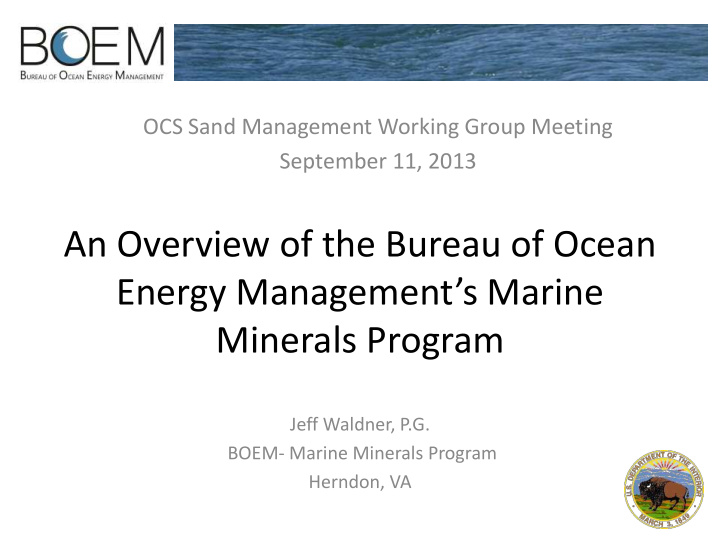



OCS Sand Management Working Group Meeting September 11, 2013 An Overview of the Bureau of Ocean Energy Management’s Marine Minerals Program Jeff Waldner, P.G. BOEM- Marine Minerals Program Herndon, VA
Background What is the OCS? • Outer Continental Shelf Lands Act of 1953 (OCSLA) • Grants authority to BOEM to lease and regulate oil, gas, sulfur, and all other minerals on the Outer Continental Shelf (OCS), including sand and gravel • Defines OCS as extending from 3 nautical miles from shore (or 3 leagues offshore Texas)
Background Marine Minerals Program • Identifies and makes available OCS material to local, state, and Federal agencies for nourishment, coastal restoration, wetlands protection projects and the protection of parks, refuges, and other Federal/State/Local public assets and projects • Provides policy direction for the development of marine mineral resources on the OCS • Collects and provides geologic and environmental information, developed through partnerships with coastal States.
Background BOEM Marine Minerals Program • Geological Investigations • Environmental Studies • Project Collaboration • Environmental Review • Resource Leasing • Project Monitoring • Emergency Response
Geological Investigations Geologic Investigations The BOEM Marine Minerals Cooperative Agreement Program collaborates with the coastal states to conduct data acquisition. Data collection typically consist of • seismic reconnaissance work to identify areas for subsequent in- depth research, • sub-bottom profiling, and • geologic sampling of sediment The information collected is used to determine if the sediment is suitable and compatible with placement beach sediment. Based on these investigations, a borrow area can be delineated.
Environmental Studies Environmental Studies Since 1990, BOEM has invested over $14 million in marine mineral environmental studies. Studies have focused on biological resources, wave modeling, and programmatic dredging impacts. Study results are used by BOEM to: • Inform environmental assessment and leasing decisions • Identify and address environmental concerns • Predict, assess, and manage environmental impacts from proposed dredging operations, and • Develop mitigation to minimize or avoid such impacts.
Project Collaboration Program Partners and Stakeholders BOEM works extensively on collaboration efforts at all levels of government, industry and the public, some examples include: – USACE, USGS, DOD, USFWS, NPS, NASA, FEMA, NOAA, EPA, and USDA – State Governors – State Environmental Agencies – Geological Surveys – Coastal State Geologists – County Governments – Dredge Industry Leaders – Higher Institutes of Learning – Youth and Educational Programs
Resource Leasing Marine Mineral Use Agreements BOEM Operates Under Two Frameworks Negotiated Noncompetitive Agreements Grant authorization through leases and memorandum of agreements for use of Federal sand, gravel, or shell resources for use in shore protection or other public works projects Competitive Sales Similar to Oil & Gas Sale with bonus bids, royalties, etc .
Resource Leasing Qualifying Projects BOEM defines coastal restoration as the rebuilding of eroding shoreline segments, such as beaches and dunes, barrier islands, and wetlands, to forestall further erosion and/or to provide protection from hurricanes, storms, and normal coastal erosion for sensitive landward wetlands areas. Assateague Island, BOEM Sandbridge Beach, VA coastal supported nourishment restoration took place in 1998, completed in 2003. 2002 and 2007
Environmental Review Environmental Review Required Environmental Review includes: – National Environmental Policy Act (NEPA) – Endangered Species Act, Section 7 – Magnuson – Stevens Fishery Conservation and Management Act, Section 305 – Coastal Zone Management Act – National Historic Preservation Act, Section 106 – Tribal Consultation – Marine Mammal Protection Act, Section 101 or 104
Project Monitoring Agreements & Stipulations After the environmental review is completed: – A Noncompetitive Agreement is negotiated – Mitigation measures and other stipulations, from the Environmental Review, are included in the agreement – These stipulations often include the following: dredging window constraints, location constraints, lighting requirements, equipment requirements, and buffers surrounding cultural resources and hard-bottom habitat.
Emergency Response Hurricane Sandy • Participated in FEMA’s National Disaster Recovery Framework • BOEM received $11.7 Million dedicated to coastal resiliency efforts – OCS Sand Resource Data Acquisition – State Cooperative Agreements – Stakeholder Engagement – Environmental Monitoring – Environmental Assessments
Conclusions Marine Minerals Program • Geological Investigations • Environmental Studies • Project Collaboration • Environmental Review • Resource Leasing • Project Monitoring • Emergency Response
Contact Information Questions? Contact: Jeffrey.Waldner@boem.gov 703-787-1779 office 703-206-8867 cell Visit our website at: http://www.boem.gov/marinemineralsprogram
Recommend
More recommend